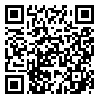1. Kianersi F, Mojabi N. Examining the contribution of sense of coherence and self-compassion in predicting flourishing in university students. Journal of New Thoughts on Education. 2018;14(2):247–62. [Persian] [
Article]
2. Roth RA, Suldo SM, Ferron JM. Improving middle school students’ subjective well-being: efficacy of a multicomponent positive psychology intervention targeting small groups of youth. School Psychology Review. 2017;46(1):21–41. [
DOI]
3. Keyes CLM. Promoting and protecting mental health as flourishing: a complementary strategy for improving national mental health. Am Psychol. 2007;62(2):95–108. [
DOI]
4. Faulk KE, Gloria CT, Steinhardt MA. Coping profiles characterize individual flourishing, languishing, and depression. Anxiety Stress Coping. 2013;26(4):378–90. [
DOI]
5. Shankland R, Rosset E. Review of brief school-based positive psychological interventions: a taster for teachers and educators. Educ Psychol Rev. 2017;29(2):363–92. [
DOI]
6. Huppert FA, So TTC. Flourishing across europe: application of a new conceptual framework for defining well–being. Soc Indic Res. 2013;110(3):837–61. [
DOI]
7. Guney S. The Positive Psychotherapy Inventory (PPTI): reliability and validity study in Turkish population. Procedia - Social and Behavioral Sciences. 2011;29:81–6. [
DOI]
8. Gonzalez TR, Ehrenzweig Y, Sanchez-Gracida OD, Enriquez-Hernandez CB, Lopez-Mora G, Martinez AJ, et al. Promotion of individual happiness and wellbeing of students by a positive education intervention. Journal of Behavior, Health & Social Issues. 2014;5(2):79–102. [
DOI]
9. Gokcen N, Hefferon K, Attree E. University students’ constructions of “flourishing” in British higher education: an inductive content analysis. International Journal of Wellbeing. 2012;2(1):1–21. [
DOI]
10. Elfrink TR, Goldberg JM, Schreurs KM, Bohlmeijer ET, Clarke AM. Positive educative programme. a whole school approach to supporting children's well-being and creating a positive school climate: a pilot study. Health Education. 2017;117(2):215–30.
11. Bao Z, Zhang W, Lai X, Sun W, Wang Y. Parental attachment and Chinese adolescents’ delinquency: the mediating role of moral disengagement. J Adolesc. 2015;44(1):37–47. [
DOI]
12. Gini G, Pozzoli T, Hymel S. Moral disengagement among children and youth: a meta-analytic review of links to aggressive behavior. Aggr Behav. 2014;40(1):56–68. [
DOI]
13. Yasaminezhad P. Tasire amoozesh hooshe akhlaghi bar masouliat paziri, hamdeli hayajani, akhlagh tahsili va bakhshoodegi beyn fardi danesh amoozan dokhtar paye sevom maghta motavasete [The effect of moral intelligence training on responsibility, emotional empathy, academic ethics and interpersonal forgiveness of female students in the third grade of high school] [PhD dissertation]. [Ahvaz, Iran]: Faculty of Psychology and Educational Sciences, Shahid Chamran University of Ahvaz; 2014. [Persian]
14. Rezapour Y, Shahedi S. The effect of moral intelligence teaching based on storytelling method on temperament and learning behaviors of elementary girl students. Journal of Applied Psychology. 2017;11(2):175–94. [Persian]
15. Sengsavang, Krettenauer. Children’s moral self-concept: the role of aggression and parent–child relationships. Merrill-Palmer Quarterly. 2015;61(2):213–35. [
DOI]
16. Dehbashi F, Sabzevari S, Tirgari B. The relationship between spiritual well-being and hope in hemodialysis patients referring to the Khatam Anbiya hospital in Zahedan 2013–2014. Medical Ethics. 2014;8(30):77–97. [Persian] [
DOI]
17. Cheung YL. Psychological first aid as a public health disaster response preparedness strategy for responders in critical incidents and disasters [PhD dissertation]. [Hong Kong, China]: The Chinese University of Hong Kong; 2014.
18. O’Sullivan G. The relationship between hope, eustress, self-efficacy, and life satisfaction among undergraduates. Soc Indic Res. 2011;101(1):155–72. [
DOI]
19. Mir Mahdi SR, Rezaali M. The effectiveness of mindfulness-based cognitive therapy on resilience, emotion regulation and life expectancy among women with diabetes2. Journal of Health Psychology. 2019;7(4):167–83. [Persian] [
DOI]
20. Rajabipour Meybodi A, Doosthosseini F. Dosthosseini F. The effect of spiritual health on academic burnout with the mediator role of life expectancy. J Biology Ethics. 2018;8(28):39–47. [
DOI]
21. Snyder CR. Handbook of hope: theory, measures, and applications. First edition. San Diego: Academic Press; 2000.
22. Moradi A, Hatamian AR, Hatamian P, Morovvati F. The relationship between practice religious beliefs and hope with elderly life satisfaction. Rooyesh-e- Ravanshenasi Journal. 2019;8(1):183–90. [Persian] [
Article]
23. Ghamari M, Mir AS. The effectiveness of teaching tolerance on anxiety of death and life expectancy of aged women residing in nursing homes. Aging Psychology. 2018;3(4):253–62. [Persian] [
Article]
24. Hooman H. Structural equation modeling with LISREL application. Tehran: Samt Pub; 2018. [Persian]
25. Soleimani S, Rezaei AM, Kianersi F, Hojabrian H, Khalili Paji K. Development and validation of Flourishing Questionnaire based on seligman's model among Iranian university students. Research & Health. 2015;5(1):3–12. [Persian]
26. Lennick D, Kiel F. Moral intelligence: enhancing business performance and leadership success. Wharton School Publishing; 2007.
27. Snyder CR, Harris C, Anderson JR, Holleran SA, Irving LM, Sigmon ST, et al. The will and the ways: development and validation of an individual-differences measure of hope. J Pers Soc Psychol. 1991;60(4):570–85. [
DOI]
28. Snyder CR, Ilardi SS, Cheavens J, Michael ST, Yamhure L, Sympson S. The role of hope in cognitive-behavior therapies. Cognit Ther Res. 2000;24(6):747–62. [
DOI]

 ، فرشاد بهاری*2
، فرشاد بهاری*2 
 ، هومن نامور3
، هومن نامور3 




